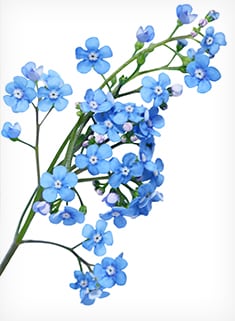Special Awareness Days
November 11th - Remembrance Day

Ready to Order?
If you are ready to order, please contact Customer Service:
Telephone: 1 (800) 361-6128 Fax: 1 (800) 563-9196
Following directly on the heels of Forget-me-not Day, Remembrance Day is a day when we remember those who engaged in wartime efforts to help us lead safe and peaceful lives. “The joys and freedoms we now enjoy are because of their sacrifices; sacrifices made in the hopes we as a people would never have to endure the horrors of war again.”
The date for Remembrance Day originates from the fact that on November 11th, at 11 a.m., in 1918, World War One ended. In Canada we celebrate this day in the memory of more than 100,000 Canadian soldiers who died so that we could have peace in the world.

The Poppy
In 1915, Lieutenant John McCrae, a WW I medical officer from Guelph, Ontario, wrote the Poem “In Flanders Fields” on a scrap of paper following the death of a fellow soldier.
After the poem was published in a magazine, an American teacher named Moina Michael read it and was so inspired by it that she pledged to always wear a poppy as a sign of remembrance.
In 1920, a French woman named Madame Guerin learned of the custom. She decided to make and sell poppies to raise money for children in war-torn areas of France. The poppy was officially adopted the Flower of Remembrance on July 5, 1921. Read more about the poppy here.
Activity Burst Ideas
You probably have lots of activities related to this very special day but here are a few that might interest you.
K-2 - The Arts
The poppy has long been the symbol that represents the importance of remembering those who sacrificed their lives so that we can live in peace (see the Introduction above).
Get the whole class involved in making a Poppy Field mural for their classroom, the gym, or the school entrance. Ask students to help you prepare the following parts of the mural:
- Poppies -- Get imaginative with materials to use. For example, cupcake liners or felt circles could work well. Add black centres.
- Field – Create lots of green grass, with some curled and some straight to suggest the wind blowing.
- White crosses to commemorate the fallen
- Maybe a picket fence made of several white pickets joined together by white shoelaces?
- Whatever else you feel would be appropriate!
Assemble the mural and sign your class or individual names.
3-5 - Language, The Arts
As our veterans age, it is sometimes difficult to arrange for someone with wartime experience to visit the classroom and share their stories. If this is not possible in your community, engage the students in a discussion about the importance of Remembrance Day (see Introduction above), and ask them to make thank-you cards for our veterans.
To prepare students for this activity, ask:
- What do you think you should say in the thank-you card?
- What are you thanking them for? (e.g., their service in the wars, their love for Canada, their part in helping us to live a life in peace…)
- What does their sacrifice mean to you?
After a rich discussion, invite students to make and decorate their thank-you card. Edit and then send them to their local Legion or Service Club.
References:
http://www.nostoneleftalone.ca/why-the-poppy
https://www.statutoryholidays.com/remembrance_day.php
6-8 - Citizenship, Language
Have students discuss the following:
- What is a veteran?
- Why do you think it is important to remember the World Wars and the people who served in our national armed forces?
- How would you describe world peace?
Engage students in a virtual Remembrance Day celebration around 11: a.m., if possible. If not, explain the significance of 11 a.m. when you discuss the ceremony (World War I officially ended at the 11th hour of the 11th day of the 11th month). As they prepare for a moment of silence, remind students to think about the many young people who gave their lives so that we would have freedom.
Invite students to create a story, poem, song, poster, mural or other form of art that represents what world peace means to them.
For additional information, you might want to consult the Teaching Guide on the Royal Canadian Legion’s website and the resource material on the Second World War (1939-1945) on the Government of Canada’s website.
Additional Ideas:
Grades K-2, 3-5 – Art, History
Have each class in your school use art materials to create a Remembrance Day stained-glass mosaic. Post them in the classroom windows or at the front of the school to commemorate those who gave their lives so that we could have peace.
Consider searching online sites such as Pinterest for examples of stained-glass paper crafting and poppy-themed art activities.
Grades 6-8 – Research, History
Remind students that some of the Canadian young men and women who enlisted in the armed forces during war, were as young as 16 (with parental consent). They came from all walks of life — all cultures, all ethnicities, all parts of our country.
Invite students to research one of the following topics and create a short presentation about what they learned:
- The first Canadian army
- The Royal Canadian Air Force
- The Royal Canadian Navy
- The role of Indigenous peoples during the Second World War
- The role of women during the Second World War
- Memorials, honours, and medals honouring Canadians who served in the Second World War.
The following link on the Government of Canada website may be a helpful starting point: Second World War (1939-1945).






